Reposted from Dr. Susan Crockford’s Polar Bear Science
Many W Hudson Bay polar bears still offshore at 7 August despite apparent low ice levels
Posted on August 9, 2020 |
Contrary to all expert expectations, five female polar bears (45%) out of eleven that had tracking collars attached last year were still out on the sea ice that’s lingering along the western shore of Hudson Bay as of 7 August. And if five collared bears are out there, then there are almost certainly many more without collars doing the same thing. This pattern of bears staying out on the ice long after the so-called ‘critical threshold’ of 50% concentration has passed has been going on since at least 2015 and many bears on tracking maps in July and August appear to be on ice that doesn’t exist.
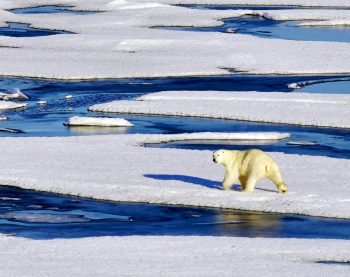
There are two explanations for this pattern and both are likely true: 1) much more ice actually exists on Hudson Bay than satellites can detect and 2) polar bear experts are wrong that Western Hudson Bay polar bears head to land soon after sea ice concentration drops below 50%. Models that predict a catastrophic future for Western Hudson Bay polar bears (Castro de la Guardia et al. 2013; Molnar et al. 2020) assume that ice coverage of less than 50% in summer greatly reduces polar bear survival. However, if polar bears do not always head to land when sea ice drops below 50% then the models cannot possibly describe their future accurately. In other words, depending on the discredited ‘worst case’ RCP8.5 climate scenario for the most recent polar bear survival model that extrapolates from Western Hudson Bay bear data to many other subpopulations, as I discussed previously, may not be its only fault.
For at least the last five years now Western Hudson Bay polar bears have stayed out on melting summer ice when it was well below 50% concentration; the same phenomenon of bears tracking to what looks like open water has also shown up for Southern Beaufort bears.
Below is biologist Andrew Derocher’s tracking map at 7 August 2020 for the bears he and colleagues put collars on last year, which shows five out of eleven bears still out on the ice:
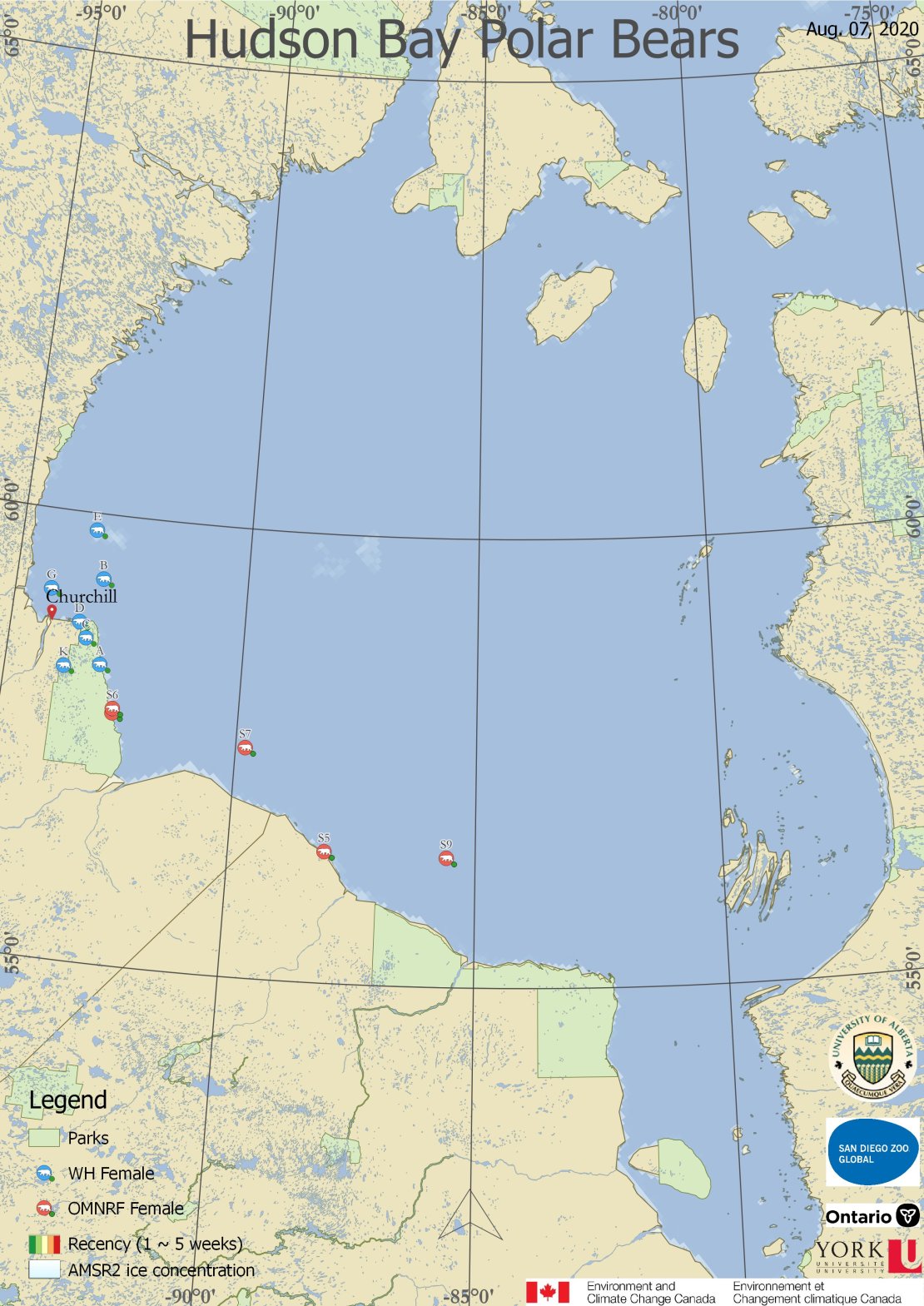
As I’ve pointed out previously, more ice is present on the bay than shows on the tracking map above because it only shows ice that’s >50% concentration. Here are the Canadian Ice Service charts for the northern and southern portions of the bay on 8 Aug:
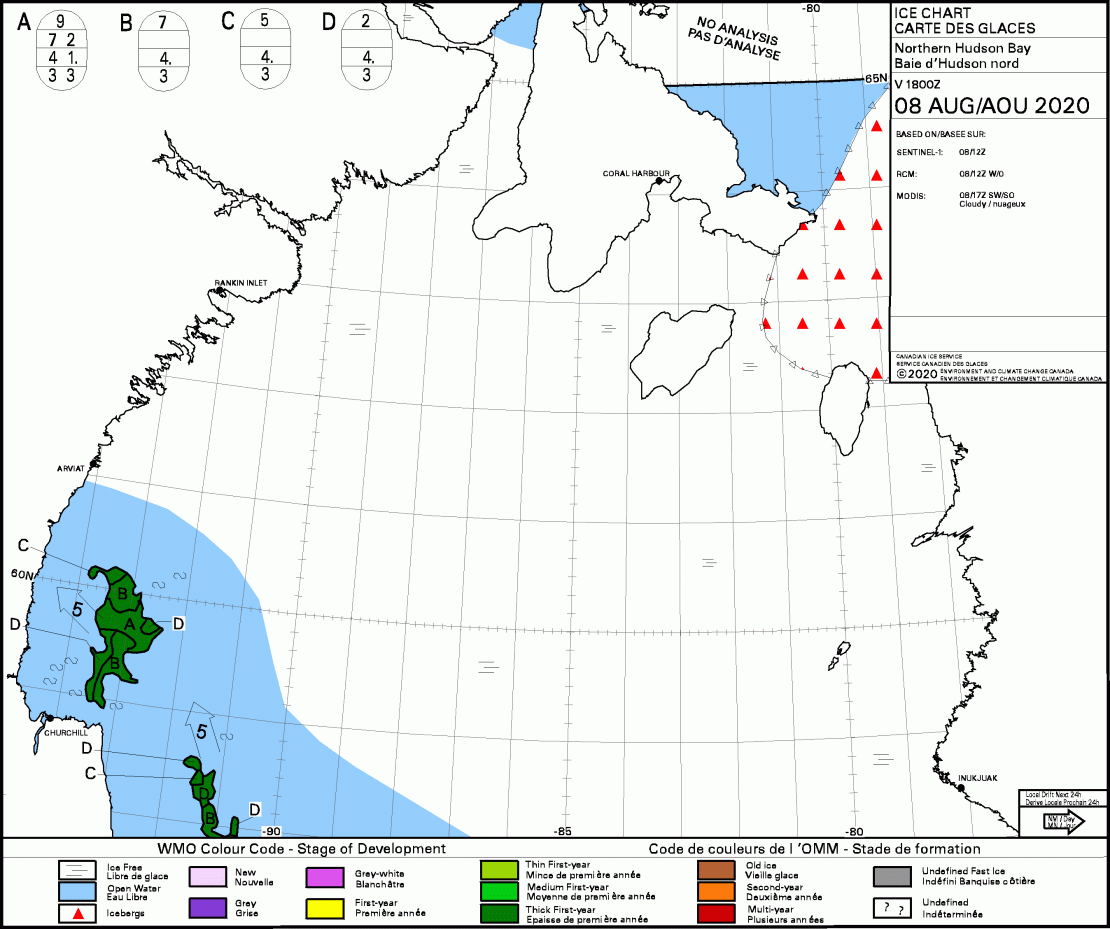
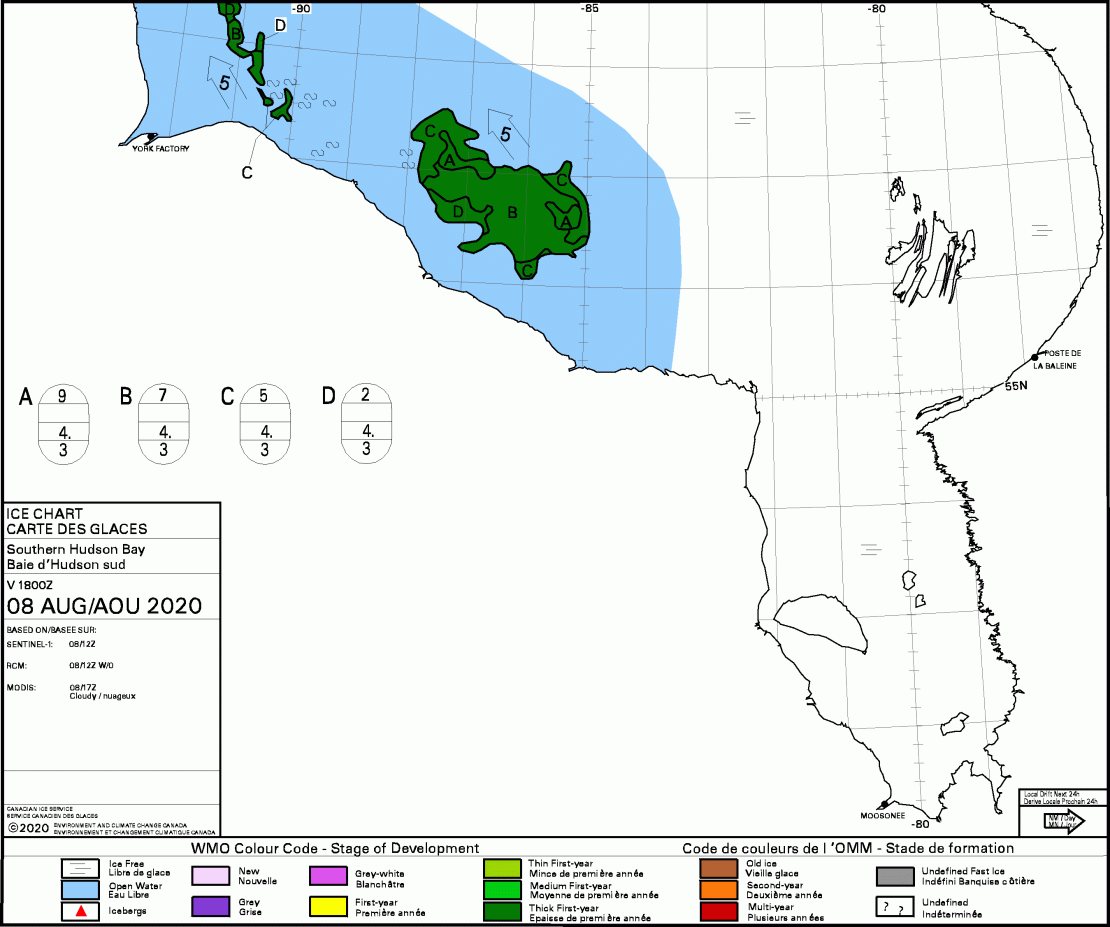
All of the ice remaining is thick first year ice, which means there is likely to be more ice than satellites can visualize because of melt-water ponding on top of the ice floes at this time of year. Polar bears are excellent swimmers and deal easily with such melt ponds. These are a regular feature of the Arctic landscape at this time of year and part of the polar bears’ natural habitat. Below is a photo of melt ponds in the Beaufort Sea at mid-July 2016 (taken by NASA).
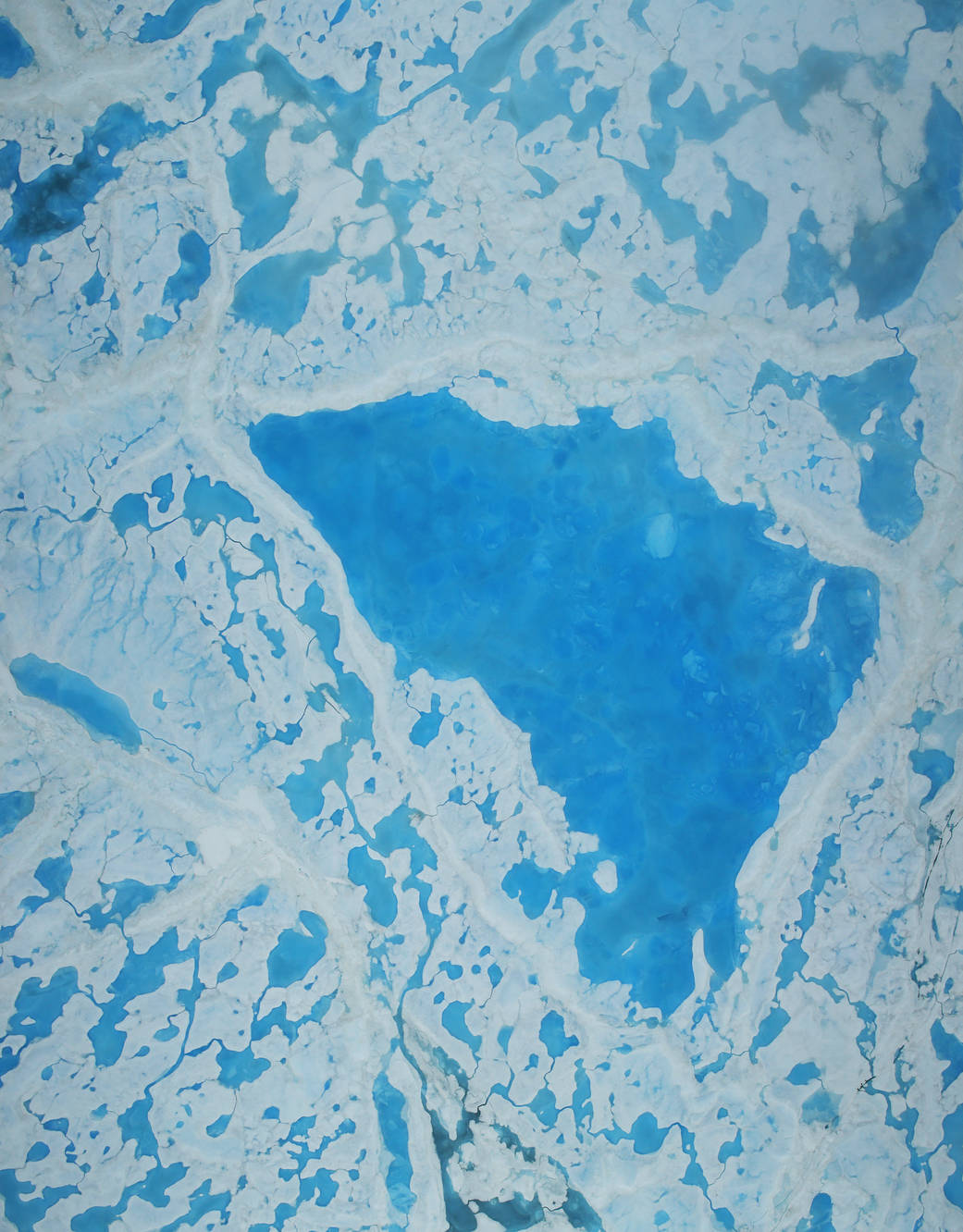
According to the satellite charts shown above, only a bit of remnant thick first year ice is left on Hudson Bay. However, even polar bear researchers know that satellites are notoriously bad at getting the amount of ice correct at this time of year and can underestimate ice amounts by up to 50% in Hudson Bay. Polar bear biologists that work with Western Hudson Bay bears, like Andrew Derocher, are aware that this is the case, as the quote below from one of his student’s papers shows (Castro de la Guardia et al. 2017:227) [my bold]:
In general, passive microwave derived sea ice data are associated with an underestimation error of up to 30% during breakup and freeze-up throughout the marginal ice zone and seasonal ice regions in the Northern Hemisphere (e.g. Cavalieri et al. 1991, Comiso et al. 1997, Markus & Dokken 2002). In Hudson Bay, passive microwave sea ice concentration can underestimate sea ice concentration by up to 50% compared with CISDA (Agnew & Howell 2003). Underestimation biases of passive microwave data are associated with the presence of wet snow and melt ponds during breakup, and with areas covered by frazil ice and young ice during freeze-up (Agnew & Howell 2003).
However, there is another possible explanation for why many WH polar bears this year (and back to 2015 at least) have remained on the ice despite the apparent ice coverage being well below 50%. That’s the probability that low ice concentrations during sea ice breakup in the summer is not a death sentence for polar bears as researchers intend on modeling their future have long assumed. Below is Derocher’s tracking map for last year at the end of July, where we see the same pattern:
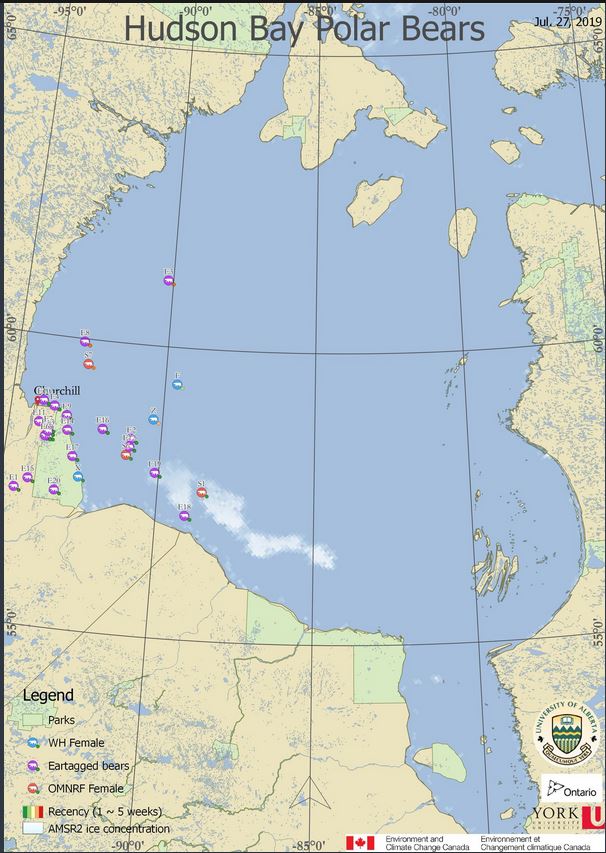
In 2018, the pattern was similar: by late July ice cover in Western Hudson Bay was apparently almost non-existent but four bears with tracking collars were still offshore (and if four collared bears were on the ice, it’s almost certain there were many more without collars):
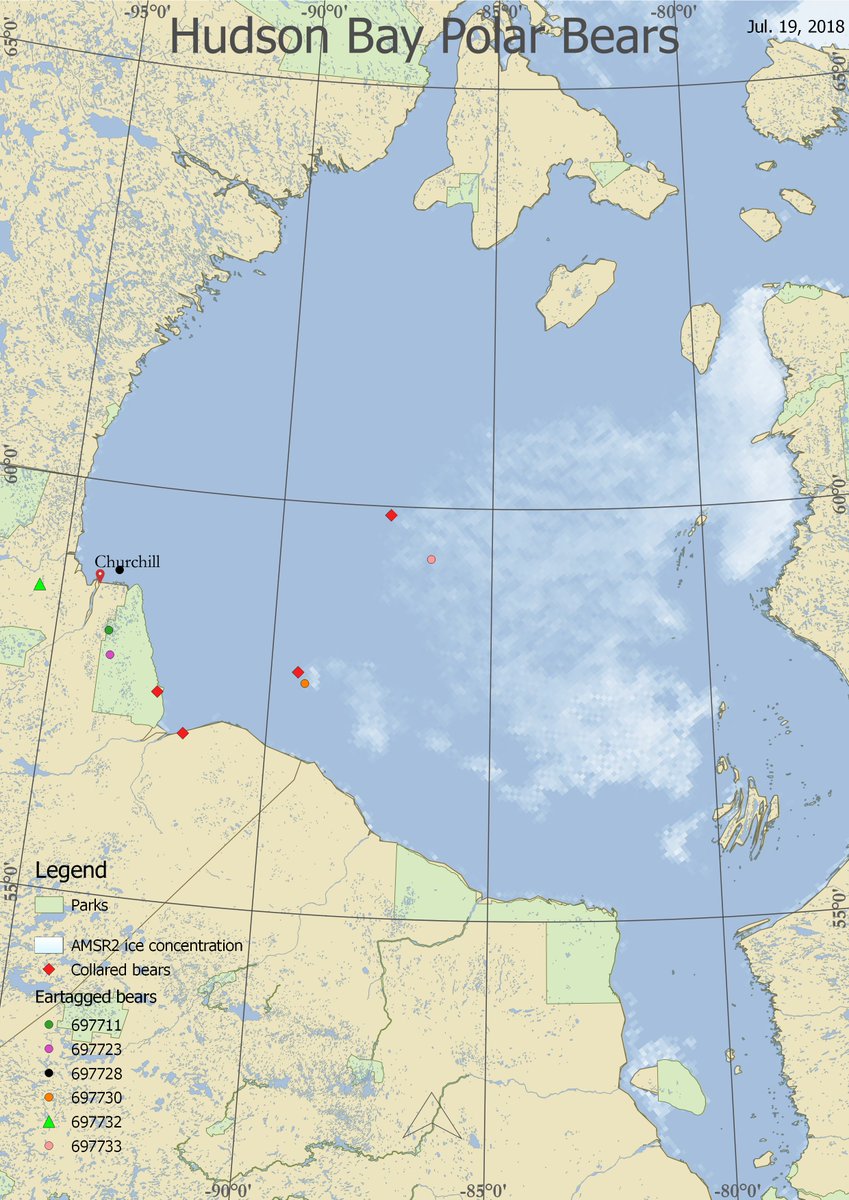
And in 2017, the story was the same. That summer was the first time I noticed Derocher suggesting that “bears may be shifting behaviour to stay out on less ice” to explain why the tagged bears were not coming ashore when the sea ice dropped below 50% as he and his colleagues expect them to do.
Derocher said something similar a few weeks ago (29 July 2020):
“4 W Hudson Bay polar bears ashore. Amazing how long they’re staying offshore as ice this low would usually have them all on land. So many still on the ice suggests a behaviour shift (i.e., behavioural plasticity). The @ualbertaScience polar bear crew is studying this.”
Only now, apparently, are Derocher and his colleagues giving any thought to the possibility that polar bears might not have rigid responses to changing sea ice conditions. No, polar bear experts looked at the sea ice was like in the 1980s and figured those conditions were what polar bears absolutely required (Amstrup et al. 2007; Castro de la Guardia et al. 2013, 2017; Durner et al. 2007; Stirling et al. 1999): they never considered the possibility that the bears could do perfectly well with less.
[I’ve been pointing out for years that after about late May to early June on Hudson Bay, there are few opportunities for polar bears to catch seals which means they would eat as little on the ice as they would do if they were on land. It’s cooler on the ice and there are no bugs, so some bears may choose to stay out as long as possible but garner no particular advantage by doing so.]
By all accounts, 2016 was a great summer for WH bears and many were out on the rapidly declining ice:
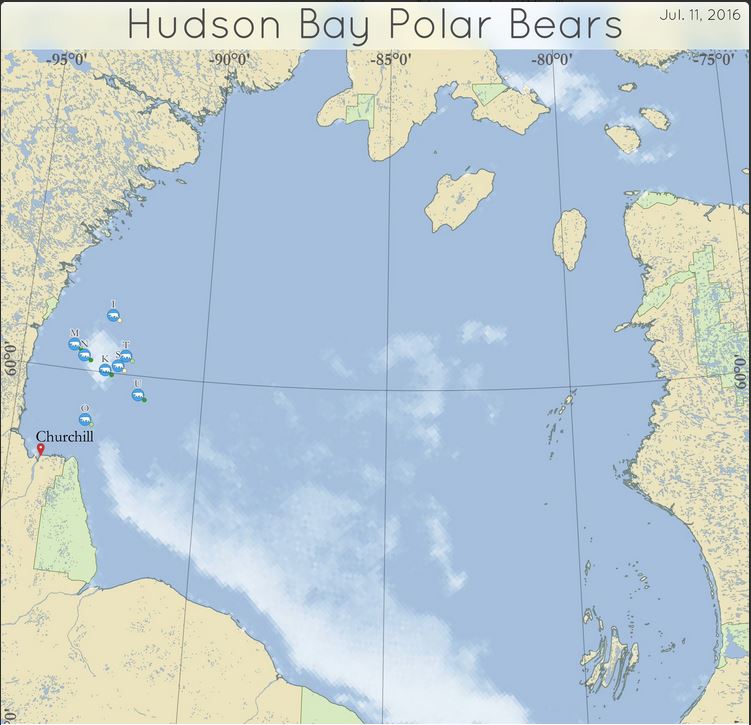
And in 2015, there were again bears on ice that shouldn’t exist:
In summary, polar bears have been doing very well in Western Hudson Bay since at least 2015 despite the fact that quite a few bears have stayed out on ice less than 50% concentration for weeks at the end of the melt season. Virtually all bears have come ashore fat and healthy over that period, whether they came ashore late or early. So the surprise about Western Hudson Bay is not just that for the last two years bears have been coming ashore fat and healthy and as late as they did in the 1980s but that their relationship with the melting ice contradicts a very basic assumption held by polar bear experts. It is apparent from what’s been happening in Hudson Bay since 2015 that polar bears do not require sea ice cover that is >50% concentration during the summer, which means that polar bear survival models developed to predict the future of the species based on this assumption are almost certainly getting the wrong answers.
PS. So far, there has not been a report from the Polar Bear Alert Program regarding problem bears in Churchill, Western Hudson Bay. As long as I’ve been collecting these published reports (2015), there has not been a first report of the season issued later than the second week in July. Even if it is issued this week, the second week in August is extraordinarily late for the first report of the season. However, it’s not clear if that’s because the bears are so late off the ice that there have been no problems yet or for some other reason. Last week I contacted the Town of Churchill, who usually post these reports on their website, and got this reply (12:46 PM 7 August 2020):
Good afternoon, thank you for your message. We have not yet received any reports from Manitoba Conservation and Climate regarding Polar Bears in the area. We have reached out, and will be posting them as they are received. Thank you.
References
Amstrup, S.C., Marcot, B.G. & Douglas, D.C. 2007. Forecasting the rangewide status of polar bears at selected times in the 21st century. US Geological Survey. Reston, VA. Pdf here
Castro de la Guardia, L., Derocher, A.E., Myers, P.G., Terwisscha van Scheltinga, A.D. and Lunn, N.J. 2013. Future sea ice conditions in Western Hudson Bay and consequences for polar bears in the 21st century. Global Change Biology 19:2675–2687. doi: 10.1111/gcb.12272
Castro de la Guardia, L., Myers, P.G., Derocher, A.E., Lunn, N.J., Terwisscha van Scheltinga, A.D. 2017. Sea ice cycle in western Hudson Bay, Canada, from a polar bear perspective. Marine Ecology Progress Series 564: 225–233. http://www.int-res.com/abstracts/meps/v564/p225-233/
Durner, G.M., Douglas, D.C., Nielson, R.M., Amstrup, S.C. and McDonald, T.L. 2007. Predicting 21st-century polar bear habitat distribution from global climate models. US Geological Survey. Reston, Virginia. Pdf here.
Molnár, P.K., Bitz, C.M., Holland, M.M., Kay, J.E., Penk, S.R. and Amstrup, S.C. 2020. Fasting season length sets temporal limits for global polar bear persistence. Nature Climate Change. https://doi.org/10.1038/s41558-020-0818-9
Stirling, I., Lunn, N.J. and Iacozza, J. 1999. Long-term trends in the population ecology of polar bears in Western Hudson Bay in relation to climate change. Arctic 52:294-306. http://arctic.synergiesprairies.ca/arctic/index.php/arctic/article/view/935/960 [open access]
There is more going on here then meets the eye. for years you could look at ice concentration and/or ice temperature and get pretty much the same picture of how much ice there is in the arctic. For the last 5 or 6 years the 2 have diverged and ice concentration is always much lower then the areas that are showing ice temperatures of 0 degrees or below. not sure why.
Years and years ago when I was in grad school we were encouraged to go to various group discussions around campus. One that I attended discussed polar bears evolving over time in response to many things. It was long enough ago that the global warming hype machine wasn’t in full force (there wasn’t a single “climate scientist” on campus – happy times).
During the discussion, which occurred in the department of Zoology, many researchers were of the opinion that Polar Bears were quite capable of evolving to be aquatic or semi-aquatic mammals over time. The notion that they were dependent on the ice wasn’t really part of the discussion. Certainly there were derived benefits from hunting above the water surface (i.e. on the ice) but it wasn’t a requirement for survival. But bears at that time (late 1980s) were known to be capable of hunting in the open water. It wasn’t a preference because there were other competitors in the water that might steal the prey.
So it strikes me that the Polar Bear is, and always has been, a pretty terrible animal to choose as your icon for ice melting. The bears are quite frankly both capable and fine. Many old timers knew the bears didn’t “need” the ice. I wonder why the new researchers haven’t figured this out. I suspect it is a result of their training that has a built in bias and expectation with it, which is really rather tragic.
The funny thing is the bears are the worst choice as an emblem of global warming because they are so adaptable. There could be ample evidence of ice melting (and in the short term I think this is the case with a relatively short term decrease in ice cover and thickness – 1979 – present) but the bears just keep sticking up their metaphorical middle finger to the notion they are going extinct.
“Many old timers knew the bears didn’t “need” the ice.”
I have made this observation before, but whoever gave polar bears the latin name must have known exactly that: Ursus Maritimus, sea bear, NOT Ursus Glacialis.
Another example of Rothbardian-style lost knowledge?
Susan,
More great work! Thanks for your efforts.
Steve
“How do we know a political partisan: When they can’t concede when the other side has ever made a good point.”
Anonymous Heins
Does this mean that polar bears are climate deniers?
Thanks, MarkW, that made me smile.
Stay safe and healthy, all.
Bob
PS: Keep at it, Susan. I thank you for your perseverance, insight, and knowledge on all things Polar Bear.
“However, even polar bear researchers know that satellites are notoriously bad at getting the amount of ice correct at this time of year and can underestimate ice amounts by up to 50% in Hudson Bay.”
How can this be, griff tells us that the fact that having ice levels a tenths of a percent under last years ice levels is proof that polar bears are all going to die.
Mark,
May I help?
” . . . griff tells us that the fact that having ice levels a tenths of a percent under last years ice levels is proof that polar bears are all going to die.”
” . . . griff tells us that the fact that having ice levels a tenths of a percent under last years ice levels is proof that polar bears are all going to die horribly, with sores and hives and starvation, and in the next three weeks!”.
Hope that helps.
Auto
[Mods – a little bit /Sarc. But only a little bit. Honestly!
They’re viable and worthy.
New title:
Polar Bears
DefyDeny SCIENCE! by Refusing to Die.Polars Bear are science deniers. Because science is the ignorance of Andrew Derocher et al.
Alternatively, “Polar Bears Defy the ignorant EXPERTS! by Refusing to Die.”
h/t Richard Feynman (RIP)
I admit that would have been better.
“so some bears may choose to stay out as long as possible but gardner no particular advantage by doing so”
Did you mean garner instead of gardner?
We need to send a few climate scientists out to check out how hungry the bears are.
Mickey Mann would be a nice prey 😀
Argh! Yes, thanks. Fixed in the original.
I’ll see if Charles can fix this copy.
“That’s the probability that low ice concentrations during sea ice breakup in the summer is not a death sentence for polar bears as researchers intend on modeling their future have long assumed. ”
An apt pun – because the researchers do indeed intend on establishing the (ever future) collapse of their polar research funding, but perhaps it should be, ” “… as researchers intent on modeling their future have long assumed.”
Derocher proposes that bears may be shifting behavior. I propose that they had no data and just guessed before.
The Bears arent shifting behaviour – only the ice is changing – and that may not be for long either…
Bears in general are an extremely adaptable set of animals with a few exceptions. I would think that if ice disappear in the summers completely, the bears will just enjoy more wild berries that are sure to be growing if it’s warmer. Over enough time the entire populations may go through some physical adaptations such as a larger or smaller average size – these changes can appear in a few generations.
I love it that they are roaming where there is “no ice”. I guess it means they have learned to walk on water? Yet another failed measurement by climate scientists.
OMG. 40% of polar bears are out on the ice. That means that 55% of all polar bears died of global warming. Or at least that’s what the msm would say.
Well, certainly the 40% of Hudson Bay polar bears still wearing active radio transmitters.
How do the bears know when it is time to swim back to shore ? The one bear looks pretty far out.
Read Arctic Dreams by Barry Lopez for a stunning description of the Polar Bear and its adaptations. No way is it going extinct! (We may, not them). But can anyone give me a reason for the BLACK NOSE which seems counterintuitive seal hunting in white- out? Do read it.
When hunting they hide it. 😀
I have read that polar bears are incredible swimmers. Can they hunt at the same time? Animals and we are animals also adapt the circumstances. To the activist that is not convenient so we continually get statements that small changes in climate will result in catastrophe. The key point is they are bears who have adapted to a cold climate. They are Apex predators who will seek to survive no matter the conditions. Ignorant supposition for activist purposes will always fail.
I suspect that it’s the hunters who are endangered.
To quibble just a bit, I would think that any recent changes in bear behavior are not “new”evolution. Rather what you’d have to call “culture”, or the expression of genes that are already present in the pool. The comma means either or, not that the latter is a form of the former.
I’d enjoy being edified if I’m not seeing the picture.
How dare they stay on the ice! Immediate action is clearly needed. Greta needs to organize eco-activists into rescue expeditions to drive the bears off the ice for their own safety. Alternately, their GPS collars should be linked to satellite data on ice cover to inform the bears of impending doom.
Can we strap a side of beef to each activist out on the ice? The bears may be hungry…
The Leftist Global Warming propaganda is wrong!? No way!
I imagine they were fine before little ice age, so would be fine now.
From AR 5, “ Our analyses highlight the potential for large reductions in the global polar bear population if sea-ice loss continues, which is forecast by climate models and other studies”.
I have this from a secondary source but believe it summarises the IPCC position in 2013.
If one goes to the entirety of the Working Group 1 passages at 28.2 of the Report, the case for threatened endangerment of polar bears or “large reductions“ in numbers relies on Papers that are no longer credible as Dr. Crockford and others indicate.
Those same polar bear experts are related to the climate change experts. they will have to change the stories as the climate doomsayers do.
Perhaps the bears have discovered a heretofore unknown source of pickanick baskets?
Maybe there should be a COVID virus made to help polar bears numbers match the models.
/sarc-off
Diversity dogma dictates fauna demographics but the polar bears are bitter clingers to life, liberty, and opportunity and refuse to self-select, including : self-abortion, dodo dynasties. #deplorable
The smartest bears have figured that taking a boat is easier than swimming.
but the ice shown by the Canadian Ice Service isn’t just based on satellite… here’s what their website says
‘Daily Ice charts represent the best estimate of ice conditions at the valid time of the chart, based on an integration of data from a variety of sources, such as satellite, and ship and aircraft-based visual observations.’
If it isn’t on an ice service chart, it isn’t there. That’s it for ice in Hudson Bay.
and there was more and later ice this year in Hudson Bay than has been usual in most of the last decade.
Meanwhile where are the bears along the entire Russian coast, where the Northern Sea Route opened early and the ice is far, far offshore?
Griff (the slanderer)
is the Russian sea ice far far off shore? if you look at the arctic sea temperature it sure doesn’t look like it.
Take the bet!
I am sure I have read somewhere (probably “Notalotofpeopleknowthat”) that Polar Bears evolved around 450 million years ago and that over that time the Arctic has been totally ice free a number of times. If the bears can withstand zero Arctic ice, why was Arctic ice ever an assumed requisite for the bears survival?
RS
Because, feelz and propaganda! That’s different….
More like 150,000 years ago.
There never seems to be just one answer:
“We compared genes between brown and white bears and were surprised. First and foremost, the polar bear as a species is less than 480,000 years old.”
https://arctic.au.dk/news-and-events/news/show/artikel/from-brown-to-white-evolution-of-the-polar-bear/
RS
Polar bears can swim 200 miles. Hudson Bay must look like a big swimming pool to them.
the occasionally Climb-out on chunk of ice and rest for bit. Resume swimming.
They are olympic swimmers.
The models can’t be wrong, the polar bears on the ice do not exist, adjust the data immediately to remove those bears from the data set then all will be as it should be.
Griff,
You said “If it isn’t on an ice service chart, it isn’t there. That’s it for ice in Hudson Bay.”
Excellent! You’ve ruled out option one (more ice than it appears), leaving option two as the answer (the bears don’t actually head for shore as soon as sea ice falls below 50% as the experts (and the models) all assume. The comments by Derocher confirm that this pattern is not what they expect and he’s been saying this since 2017.
You then said “and there was more and later ice this year in Hudson Bay than has been usual in most of the last decade.”
Not true at all. Last year the melt pattern was virtually identical and Western Hudson Bay bears behaved the same: many stayed out late on the little bit of ice that remained. This is, in fact, the second year in a row that ALL WH bears have not been off the ice until early August. In 2017, the low level of ice came about two weeks sooner but the bears behavied the same: many stayed out on little patches of ice into mid-July. As Derocher said in 2017, that went against his expectation that all bears would be onshore at that point.
You said: “Meanwhile where are the bears along the entire Russian coast, where the Northern Sea Route opened early and the ice is far, far offshore?”
Irrelevant to the issue under discussion, except perhaps that it gives me an opportunity to point out (yet again) that polar bears eat little or nothing during the summer whether they are on the ice or on shore because the adult seals that are available are so hard to catch at that time of year that it’s not worth the effort for most bears (a few get good at it through practice but most don’t bother).
Derocher is fond of saying (on twitter) that ‘even one extra seal’ will make a difference in survival for polar bears during this breakup period but there is nothing I’ve seen in the literature that supports that claim. It’s not surprising that as often as he makes this kind of statement, he never provides any evidence to support it.
Wow.
Griff got intellectually bitch-slapped pretty hard by Dr Crockford.
And remember, Griff was the troll telling us a while ago that Dr Crockford was unqualified to discuss Polar bears.
Er, has anyone told the greenies that polar bears know how to swim? I thought not…